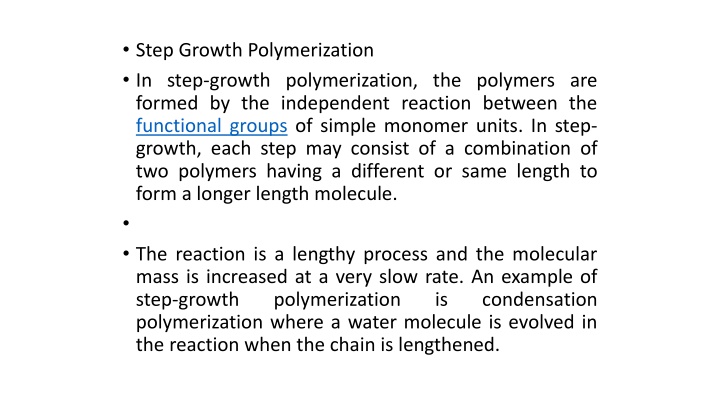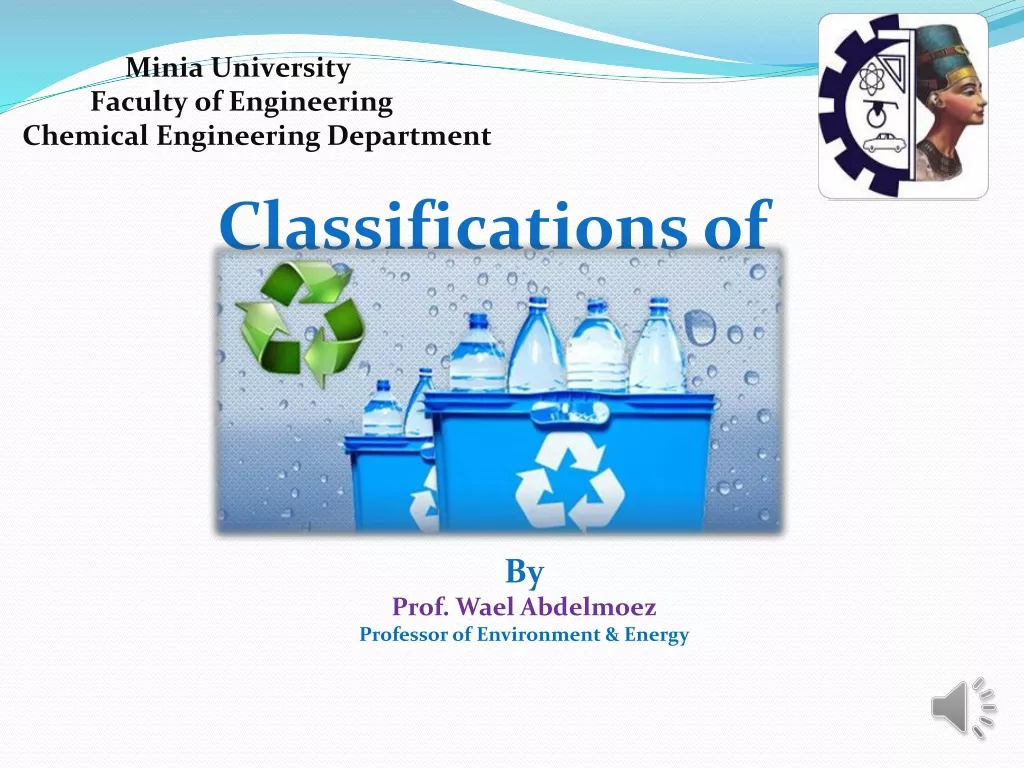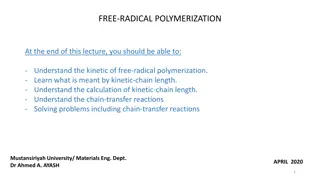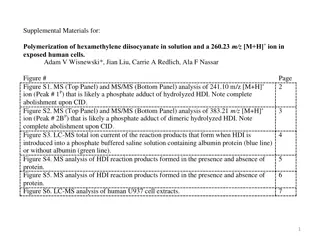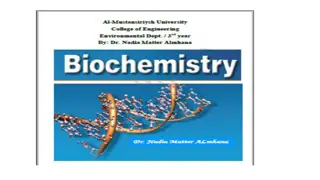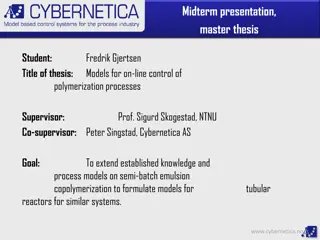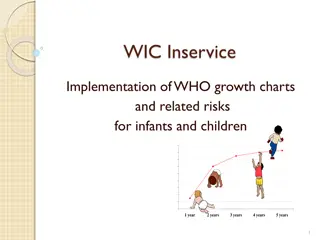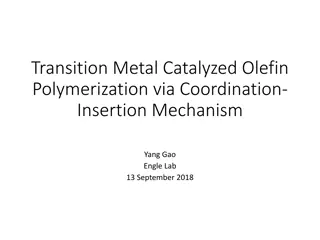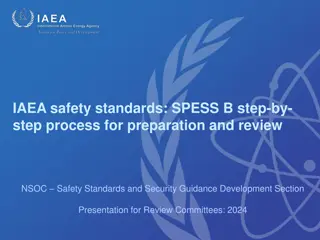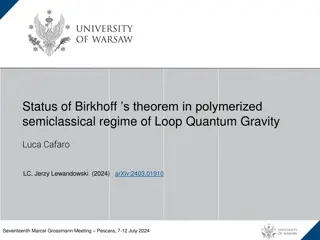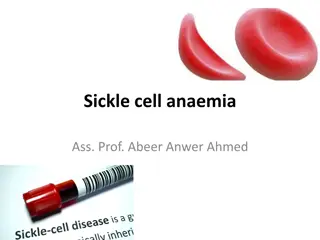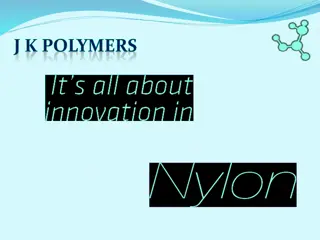• Step Growth Polymerization
In step-growth polymerization, polymers form through independent reactions of functional groups in monomer units. This process leads to the gradual building of polymer chains, resulting in diverse properties and applications for the final product. Unlike chain-growth polymerization, step-growth polymerization involves the direct linkage of monomers without the generation of reactive centers. Understanding the mechanisms behind step-growth polymerization is crucial for designing tailored polymers with specific characteristics for various industries such as materials science, biotechnology, and more.
Download Presentation

Please find below an Image/Link to download the presentation.
The content on the website is provided AS IS for your information and personal use only. It may not be sold, licensed, or shared on other websites without obtaining consent from the author.If you encounter any issues during the download, it is possible that the publisher has removed the file from their server.
You are allowed to download the files provided on this website for personal or commercial use, subject to the condition that they are used lawfully. All files are the property of their respective owners.
The content on the website is provided AS IS for your information and personal use only. It may not be sold, licensed, or shared on other websites without obtaining consent from the author.
E N D
Presentation Transcript
Step Growth Polymerization In step-growth polymerization, the polymers are formed by the independent reaction between the functional groups of simple monomer units. In step- growth, each step may consist of a combination of two polymers having a different or same length to form a longer length molecule. The reaction is a lengthy process and the molecular mass is increased at a very slow rate. An example of step-growth polymerization polymerization where a water molecule is evolved in the reaction when the chain is lengthened. is condensation
Condensation Polymerization In condensation polymerization, the formation of the polymer occurs when there is a loss of some small molecules as byproducts through the reaction where molecules are joined together. The byproducts formed may be water or hydrogen chloride. Polyamide and proteins are examples of condensation polymers. Some of the different types of condensation polymerization are given below
Polyamides They are synthetic fibres and are called as nylons. These polymers have an amide linkage between them. Condensation polymerization of di-amines with di-carboxylic acid and also of amino acids and their lactams will create a polyamide. Nylon 66: This polymer is prepared under the condition of high pressure and temperature by the condensation polymerization of hexamethylenediamine with adipic acid. Nylon 6: Prepared by heating of caprolactam with water under high temperature. It is used for tyre cords, fabrics and ropes.
Polyesters When dicarboxylic acids and diols undergo polycondensation, polyesters are formed. Prepared by heating a mixture of terephthalic acid and ethylene glycol at 460 k by using zinc acetate antimony trioxide as a catalyst. Dacron or terylene are the best-known examples for polyesters. And also they are used for glass reinforcing materials in safety helmets. Phenol-Formaldehyde Polymer These are the old synthetic polymers, obtained by condensation polymerization of phenol with formaldehyde in the presence of either an acid or base as a catalyst.
Novolac on heating with formaldehyde undergoes crosslinking and forms an infusible sold mass named as Bakelite. They are used for combs, electric switches and phonograph records. Melamine Formaldehyde Polymer It is formed by the condensation polymerization of melamine and formaldehyde in certain conditions. They are used for the manufacture of unbreakable crockery.
Chain Growth Polymerization In chain-growth polymerization, the molecules of the monomers are added together to form a large chain. The monomers adding maybe the same type or different. Generally, alkenes, alkadienes and their derivatives are used. In this mode, lengthening of chains occurs as a result of the formation of either free radicals or ionic species.
Free Radical Mechanism Many of the monomers like alkenes or dienes and their derivatives are polymerized in the presence of free radicals. In the polymerization of ethene to polythene by heating or exposing to light by using a small amount of benzoyl peroxide initiator. The phenyl free radical formed by peroxide is added to the ethene double bond and hence formed a new larger free radical. It is called a chain initiation step. This newly formed radical will reacts with another molecule of ethene to form another new free radical and so on. This repeated formation of a new free radical is called chain propagation. Finally, at some stage, the polymerized product will be formed and this step is called a chain termination step. The steps are given below.
Polymerization Polymerization, any process in which relatively small molecules, called monomers, combine chemically to produce a very large chainlike or network molecule, called a polymer. The monomer molecules may be all alike, or they may represent two, three, or more different compounds. Usually at least 100 monomer molecules must be combined to make a product that has certain unique physical properties such as elasticity, high tensile strength, or the ability to form fibres that differentiate polymers from substances composed of smaller and simpler molecules; often, many thousands of monomer units are incorporated in a single molecule of a polymer. The formation of stable covalent chemical bonds between the monomers sets polymerization apart from other processes, such as crystallization, in which large numbers of molecules aggregate under the influence of weak intermolecular forces.
What is Polymerization? Polymerization is a process through which a large number of monomer molecules react together to form a polymer. The macromolecules produced from a polymerization may have a linear or a branched structure. They can also assume the shape of a complex, three-dimensional network. There exist several different categories reactions, the most notable of which being step- growth polymerization, chain-growth polymerization (both of which fall under the category of addition polymerization), and condensation polymerization of polymerization
A polymer is a substance that is made up very large molecules that are, in turn, made up of many repeating units called monomers. Polymerization is the process through which these monomers come together to form the macromolecules that constitute polymers. An illustration detailing the polymerization of the monomer styrene into the polymer known as polystyrene is provided below.
Depending on the functional groups present in the reacting monomers, the complexity of the mechanism of the polymerization reaction may vary. The most simple polymerization reactions involve the formation of polymers from alkenes via free-radical reaction. Polyethylene, which is one of the most commercially important polymers, is prepared via such a polymerization process (the reactant monomer used here is ethylene).
It can be noted that polymerizations involving only one type of monomer are called homopolymerizations whereas those involving more than one type of monomer are called copolymerization processes. Polymerization in the simplest form can be described as a chemical process that results in the formation of polymers. In simple words, we can basically describe Polymerization as the process of creating polymers. When polymerization occurs, the smaller molecules which are known as monomers via chemical reaction are combined to form larger molecules. A collection of these large molecules form a polymer. The term polymer in general means large molecules with higher molecular mass. They are also referred to as macromolecules.
Polymers are formed by the addition of a network of structural units or monomers as mentioned above. The interesting part is that these are reactive molecules and are usually linked to each other by covalent bonds. These monomers add together to form a long chain to form a product with specific properties. This whole process of formation of polymers is polymerization. Polythene and Nylon 66 are some examples of polymers.
Mechanism of Polymerization Generally, polymerization consists of three steps which include initiation, propagation, and termination. As for the reaction mechanism, the process of polymerization mainly involves two different methods. These include the step-growth mechanism and chain-growth
